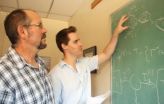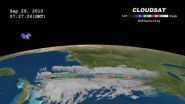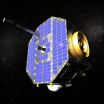(Press-News.org) What do a car engine, a power plant, a factory and a solar panel have in common? They all generate heat – a lot of which is wasted.
University of Arizona physicists have discovered a new way of harvesting waste heat and turning it into electrical power.
Using a theoretical model of a so-called molecular thermoelectric device, the technology holds great promise for making cars, power plants, factories and solar panels more efficient, to name a few possible applications. In addition, more efficient thermoelectric materials would make ozone-depleting chlorofluorocarbons, or CFCs, obsolete.
The research group led by Charles Stafford, associate professor of physics, published its findings in the September issue of the scientific journal, ACS Nano.
"Thermoelectricity makes it possible to cleanly convert heat directly into electrical energy in a device with no moving parts," said lead author Justin Bergfield, a doctoral candidate in the UA College of Optical Sciences.
"Our colleagues in the field tell us they are pretty confident that the devices we have designed on the computer can be built with the characteristics that we see in our simulations."
"We anticipate the thermoelectric voltage using our design to be about 100 times larger than what others have achieved in the lab," Stafford added.
Catching the energy lost through waste heat has been on the wish list of engineers for a long time but, so far, a concept for replacing existing devices that is both more efficient and economically competitive has been lacking.
Unlike existing heat-conversion devices such as refrigerators and steam turbines, the devices of Bergfield and Stafford require no mechanics and no ozone-depleting chemicals. Instead, a rubber-like polymer sandwiched between two metals acting as electrodes can do the trick.
Car or factory exhaust pipes could be coated with the material, less than 1 millionth of an inch thick, to harvest energy otherwise lost as heat and generate electricity.
The physicists take advantage of the laws of quantum physics, a realm not typically tapped into when engineering power-generating technology. To the uninitiated, the laws of quantum physics appear to fly in the face of how things are "supposed" to behave.
The key to the technology lies in a quantum law physicists call wave-particle duality: Tiny objects such as electrons can behave either as a wave or as a particle.
"In a sense, an electron is like a red sports car," Bergfield said. "The sports car is both a car and it's red, just as the electron is both a particle and a wave. The two are properties of the same thing. Electrons are just less obvious to us than sports cars."
Bergfield and Stafford discovered the potential for converting heat into electricity when they studied polyphenyl ethers, molecules that spontaneously aggregate into polymers, long chains of repeating units. The backbone of each polyphenyl ether molecule consists of a chain of benzene rings, which in turn are built from carbon atoms. The chain link structure of each molecule acts as a "molecular wire" through which electrons can travel.
"We had both worked with these molecules before and thought about using them for a thermoelectric device," Bergfield said, "but we hadn't really found anything special about them until Michelle Solis, an undergrad who worked on independent study in the lab, discovered that, low and behold, these things had a special feature."
Using computer simulations, Bergfield then "grew" a forest of molecules sandwiched between two electrodes and exposed the array to a simulated heat source.
"As you increase the number of benzene rings in each molecule, you increase the power generated," Bergfield said.
The secret to the molecules' capability to turn heat into power lies in their structure: Like water reaching a fork in a river, the flow of electrons along the molecule is split in two once it encounters a benzene ring, with one flow of electrons following along each arm of the ring.
Bergfield designed the benzene ring circuit in such a way that in one path the electron is forced to travel a longer distance around the ring than the other. This causes the two electron waves to be out of phase once they reunite upon reaching the far side of the benzene ring. When the waves meet, they cancel each other out in a process known as quantum interference. When a temperature difference is placed across the circuit, this interruption in the flow of electric charge leads to the buildup of an electric potential – voltage – between the two electrodes.
Wave interference is a concept exploited by noise-cancelling headphones: Incoming sound waves are met with counter waves generated by the device, wiping out the offending noise.
"We are the first to harness the wave nature of the electron and develop a concept to turn it into usable energy," Stafford said.
Analogous to solid state versus spinning hard drive type computer memory, the UA-designed thermoelectric devices require no moving parts. By design, they are self-contained, easier to manufacture and easier to maintain compared to currently available technology.
"You could just take a pair of metal electrodes and paint them with a single layer of these molecules," Bergfield said. "That would give you a little sandwich that would act as your thermoelectric device. With a solid-state device you don't need cooling agents, you don't need liquid nitrogen shipments, and you don't need to do a lot of maintenance."
"You could say, instead of Freon gas, we use electron gas," Stafford added.
"The effects we see are not unique to the molecules we used in our simulation," Bergfield said. "Any quantum-scale device where you have a cancellation of electric charge will do the trick, as long as there is a temperature difference. The greater the temperature difference, the more power you can generate."
Molecular thermoelectric devices could help solve an issue currently plaguing photovoltaic cells harvesting energy from sunlight.
"Solar panels get very hot and their efficiency goes down," Stafford said. "You could harvest some of that heat and use it to generate additional electricity while simultaneously cooling the panel and making its own photovoltaic process more efficient."
"With a very efficient thermoelectric device based on our design, you could power about 200 100-Watt light bulbs using the waste heat of an automobile," he said. "Put another way, one could increase the car's efficiency by well over 25 percent, which would be ideal for a hybrid since it already uses an electrical motor."
So, next time you watch a red sports car zip by, think of the hidden power of the electron and how much more efficient that sports car could be with a thermoelectric device wrapped around its exhaust pipe.
INFORMATION:
Reference: Giant Thermoelectric Effect from Transmission Supernodes. Justin Bergfield, Michelle Solis, and Charles Stafford. ACS Nano Sept. 2010.
Funding for this research was provided by the University of Arizona physics department.
Turning waste heat into power
Taking advantage of quantum physics, a new way of harvesting waste heat and turning it into electrical power holds great promise for making cars, power plants, factories and solar panels more efficient
2010-10-01
ELSE PRESS RELEASES FROM THIS DATE:
New report on street lighting technologies available from NLPIP at Rensselaer Polytechnic Institute
2010-10-01
Troy, N.Y. – The National Lighting Product Information Program (NLPIP) released its latest Specifier Report, designed to provide objective performance information on existing street lighting technologies -- including light-emitting diode (LED), induction, and high pressure sodium (HPS) streetlights. This report comes at a critical time when many municipalities, some with funding from the American Recovery and Reinvestment Act of 2009, are in the process of replacing HPS streetlights with LED and induction models.
NLPIP, established by Rensselaer Polytechnic Institute's ...
Newly discovered planet may have water on its surface
2010-10-01
A team of astronomers that includes the University of Hawaiʻi' at Manoa's Nader Haghighipour has announced the discovery of a planet that could have liquid water on its surface.
The planet, which is probably 30 percent larger than Earth, was discovered using one of the telescopes of the W. M. Keck Observatory on Mauna Kea. It orbits a relatively small star, Gliese 581, that is 20 light-years from Earth in the constellation Libra.
"By determining the orbit of this planet, we can deduce that its surface temperature is similar to that of Earth," said Haghighipour. ...
NOAA-sponsored scientists first to map offshore San Andreas Fault and associated ecosystems
2010-10-01
For the first time, scientists are using advanced technology and an innovative vessel to study, image, and map the unexplored offshore Northern San Andreas Fault from north of San Francisco to its termination at the junction of three tectonic plates off Mendocino, Calif.
The team includes scientists from NOAA's National Marine Fisheries Service, Oregon State University, the California Seafloor Mapping Program, the U.S. Geological Survey and Woods Hole Oceanographic Institution. The expedition which concludes Sunday is sponsored by NOAA's Office of Ocean Exploration and ...
Underwater robot swims free thanks to York U-designed wireless controller
2010-10-01
TORONTO, Sept. 30, 2010 – A waterproof controller designed and built by York University researchers is allowing an underwater robot to go "wireless" in a unique way.
AQUA, an amphibious, otter-like robot, is small and nimble, with flippers rather than propellers, designed for intricate data collection from shipwrecks and reefs.
The robot, a joint project of York, McGill and Dalhousie universities, can now be controlled wirelessly using a waterproof tablet built at York. While underwater, divers can program the tablet to display tags onscreen, similar to barcodes read ...
Story tips from the US Department of Energy's Oak Ridge National Laboratory October 2010
2010-10-01
NANO -- World's smallest antenna . . .
Instead of the conventional long piece of metal or dipole antenna, electronic devices of tomorrow could incorporate an antenna no bigger than a gnat. This is made possible by a design that allows an electrically charged nano-mechanical oscillator to be tuned to specific electromagnetic waves. "Gone will be the days when we need to match the antenna length to the wavelength," said Panos Datskos, a co-developer of this proprietary technology. The potentially revolutionary system detects very small electric fields over large frequency ...
Plants that move: How a New Zealand species disperses seeds in a high alpine, wet environment
2010-10-01
High in an alpine meadow, Gesine Pufal, from the University of Wellington, New Zealand, crouched low to the ground and splashed some water from her water bottle on a low green plant cushion, then sat back waiting to see if something would move. Sound crazy? Many hikers passing by her may have thought so, but Pufal was trying to find potential plant species that possess a type of plant movement called hygrochasy.
Although the ability to move is typically thought to be a characteristic unique to the animal kingdom, plants are also capable of movement, from the sudden ...
NASA satellites see Nicole become a remnant, another low soaking US East Coast
2010-10-01
Tropical Storm Nicole was a tropical storm for around 6 hours before it weakened into a remnant low pressure area and is now off the Florida coast. NASA Satellite imagery captured different views of Nicole's clouds as the system weakened back into a low pressure area.
While Nicole weakened, a huge trough of low pressure over the U.S. eastern seaboard from Florida to Maine has become the key weathermaker there. The trough, an elongated area of low pressure, is streaming tropical moisture from Nicole's remnants and the Gulf of Mexico, bringing high rainfall totals and severe ...
Women's study finds longevity means getting just enough sleep
2010-10-01
A new study, derived from novel sleep research conducted by University of California, San Diego researchers 14 years earlier, suggests that the secret to a long life may come with just enough sleep. Less than five hours a night is probably not enough; eight hours is probably too much.
A team of scientists, headed by Daniel F. Kripke, MD, professor emeritus of psychiatry at UC San Diego School of Medicine, revisited original research conducted between 1995 and 1999. In that earlier study, part of the Women's Health Initiative, Kripke and colleagues had monitored 459 women ...
IBEX finds surprising changes at solar boundary
2010-10-01
When NASA launched the Interstellar Boundary Explorer (IBEX) on October 19, 2008, space physicists held their collective breath for never-before-seen views of a collision zone far beyond the planets, roughly 10 billion miles away. That's where the solar wind, an outward rush of charged particles and magnetic fields continuously spewed by the Sun, runs into the flow of particles and fields that permeates interstellar space in our neighborhood of the Milky Way galaxy.
No spacecraft had ever imaged the collision zone, which occurs in a region known as the heliosheath, because ...
NIH scientists describe how salmonella bacteria spread in humans
2010-10-01
VIDEO:
See a time-lapse series showing hyper-replication of Salmonella bacteria (red) in epithelial cells from two to seven hours after infection.
Click here for more information.
New findings by National Institutes of Health scientists could explain how Salmonella bacteria, a common cause of food poisoning, efficiently spread in people. In a study published this week in the Proceedings of the National Academy of Sciences, researchers describe finding a reservoir of rapidly ...
LAST 30 PRESS RELEASES:
Sleeping in on weekends may help boost teens’ mental health
Study: Teens use cellphones for an hour a day at school
After more than two years of war, Palestinian children are hungry, denied education and “like the living dead”
The untold story of life with Prader-Willi syndrome - according to the siblings who live it
How the parasite that ‘gave up sex’ found more hosts – and why its victory won’t last
When is it time to jump? The boiling frog problem of AI use in physics education
Twitter data reveals partisan divide in understanding why pollen season's getting worse
AI is quick but risky for updating old software
Revolutionizing biosecurity: new multi-omics framework to transform invasive species management
From ancient herb to modern medicine: new review unveils the multi-targeted healing potential of Borago officinalis
Building a global scientific community: Biological Diversity Journal announces dual recruitment of Editorial Board and Youth Editorial Board members
Microbes that break down antibiotics help protect ecosystems under drug pollution
Smart biochar that remembers pollutants offers a new way to clean water and recycle biomass
Rice genes matter more than domestication in shaping plant microbiomes
Ticking time bomb: Some farmers report as many as 70 tick encounters over a 6-month period
Turning garden and crop waste into plastics
Scientists discover ‘platypus galaxies’ in the early universe
Seeing thyroid cancer in a new light: when AI meets label-free imaging in the operating room
Neutrophil-to-lymphocyte ratio may aid risk stratification in depressive disorder
2026 Seismological Society of America Annual Meeting
AI-powered ECG analysis offers promising path for early detection of chronic obstructive pulmonary disease, says Mount Sinai researchers
GIMM uncovers flaws in lab-grown heart cells and paves the way for improved treatments
Cracking the evolutionary code of sleep
Medications could help the aging brain cope with surgery, memory impairment
Back pain linked to worse sleep years later in men over 65, according to study
CDC urges ‘shared decision-making’ on some childhood vaccines; many unclear about what that means
New research finds that an ‘equal treatment’ approach to economic opportunity advertising can backfire
Researchers create shape-shifting, self-navigating microparticles
Science army mobilizes to map US soil microbiome
Researchers develop new tools to turn grain crops into biosensors
[Press-News.org] Turning waste heat into powerTaking advantage of quantum physics, a new way of harvesting waste heat and turning it into electrical power holds great promise for making cars, power plants, factories and solar panels more efficient


